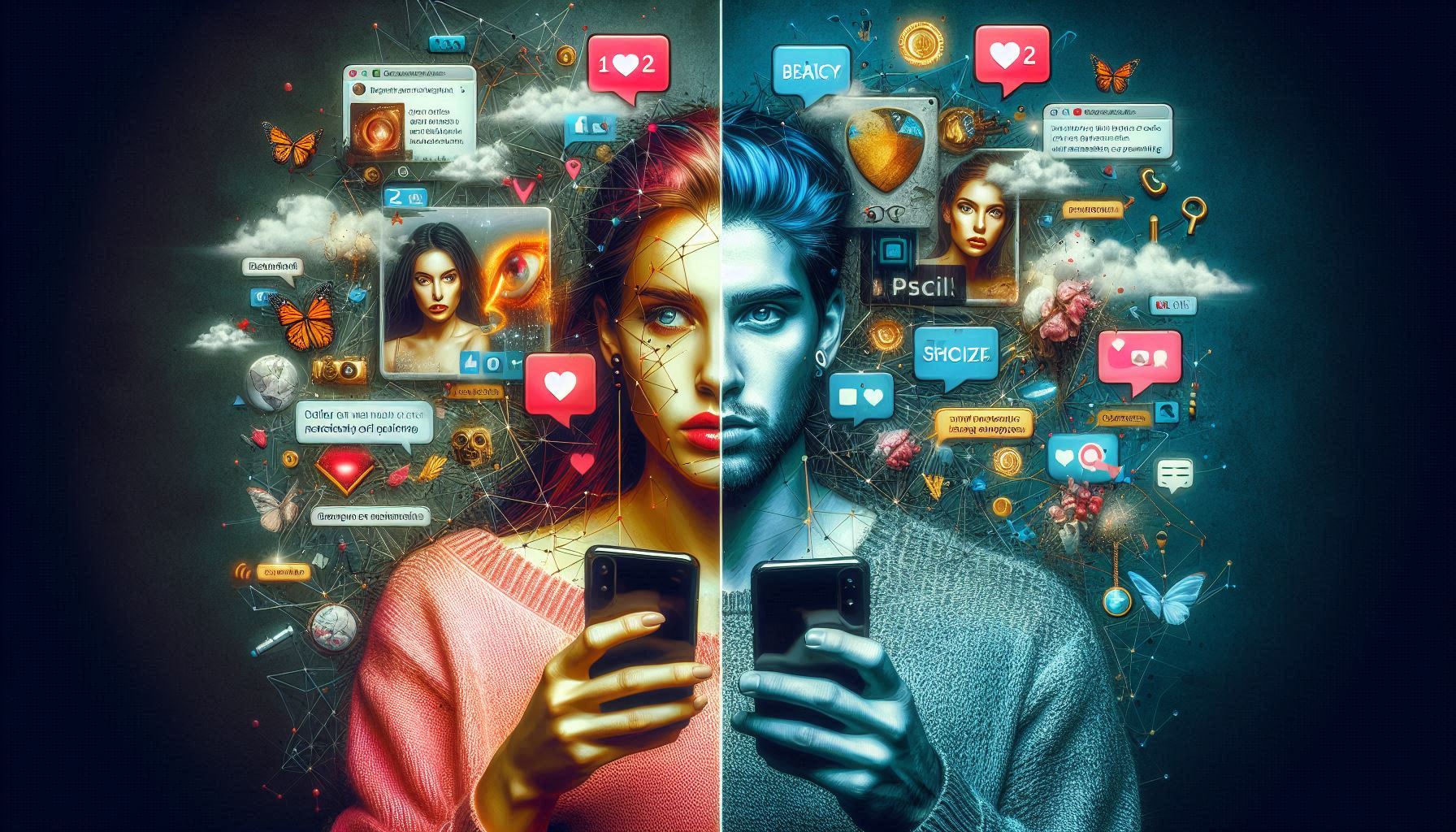Social media has transformed the way people connect, communicate, and consume information. While it offers numerous benefits, such as instant communication and access to knowledge, it also comes with significant mental health risks. These risks are not distributed evenly across genders, as men and women experience and react to social media in distinct ways. This article explores how social media impacts mental health differently for men and women, the underlying factors contributing to these disparities, and actionable strategies to mitigate harm while leveraging the positive aspects of social platforms.
The Rise of Social Media and Its Mental Health Implications
Since the early 2000s, social media platforms like Facebook, Integra, Twitter, and Ticktack have become integral to daily life. They provide a means to stay informed, share experiences, and foster relationships. However, they also create environments that can negatively impact mental health. Studies have shown links between excessive social media use and issues such as anxiety, depression, low self-esteem, and loneliness. These effects are influenced by gender roles, societal expectations, and behavioral patterns, shaping unique experiences for men and women.
Women, Social Media, and Mental Health
1. Body Image and Comparison Culture
Women are disproportionately affected by the appearance-centric nature of platforms like Integra and Ticktack. The prevalence of curated, filtered, and often unrealistic portrayals of beauty fosters a culture of comparison. Women frequently find themselves comparing their appearance to influencers, celebrities, and even their peers. This can lead to body dissatisfaction, eating disorders, and feelings of inadequacy.
A 2021 study by the Center for Countering Digital Hate found that Integra’s algorithm amplified content promoting weight loss and diet culture to teenage girls, exacerbating these issues. Furthermore, social pressures to look “perfect” often begin in adolescence and persist into adulthood, affecting self-esteem and mental health.
2. Cyber bullying and Harassment
Women are more likely than men to experience cyber bullying and online harassment, ranging from derogatory comments to threats of violence. According to a 2020 Pew Research Center report, 33% of women under 35 reported experiencing sexual harassment online compared to 11% of men. These incidents contribute to anxiety, depression, and feelings of vulnerability.
Harassment often targets women’s appearance, opinions, or gender identity. Female activists, journalists, and public figures are especially vulnerable, facing coordinated attacks designed to silence them. The psychological toll of such experiences cannot be overstated.
3. FOMO (Fear of Missing Out)
Social media’s highlight reel effect—where users showcase only the best parts of their lives—can lead women to feel they are falling short socially or professionally. This fear of missing out (FOMO) is particularly acute among women, who may feel pressure to “keep up” with peers or trends. Studies show that FOMO is linked to increased anxiety and decreased life satisfaction.
4. Overrepresentation in Caregiving Roles
Women often engage with social media for caregiving purposes, such as connecting with support groups, seeking parenting advice, or organizing family events. While these activities can be beneficial, they also increase exposure to judgment and unsolicited advice, which can lead to feelings of inadequacy or burnout.
Men, Social Media, and Mental Health
1. Toxic Masculinity and Emotional Suppression
Men face societal norms that discourage emotional vulnerability. On social media, this can manifest as pressure to project strength, success, and stoicism. Platforms like Twitter and Reedit often amplify toxic masculinity by normalizing aggressive or dismissive behavior toward those who express vulnerability.
Men who engage with such content may suppress their emotions, leading to isolation and untreated mental health issues. This contributes to the alarming rates of suicide among men, who are statistically less likely than women to seek professional help.
2. Addiction to Validation
While women often struggle with appearance-based comparison, men may become addicted to validation through metrics like likes, shares, or follower counts. For instance, male users who post about fitness, wealth, or achievements may tie their self-worth to online engagement. When such validation is absent or diminished, it can lead to feelings of inadequacy or failure.
3. Online Aggression and Identity
Men are more likely to engage in or be exposed to online aggression, whether through gaming communities, forums, or social debates. While some may use aggression as a coping mechanism for underlying frustrations, others become targets of it. This perpetuates a cycle of hostility that affects mental health, fostering anger, resentment, and loneliness.
4. Disconnection from Reality
Social media’s curated portrayals of success and masculinity can create unrealistic standards for men. Constant exposure to influencers showcasing luxury lifestyles, athleticism, or dominance may lead to feelings of inadequacy. This disconnection from reality can exacerbate depression and anxiety, particularly in young men.
Commonalities across Genders
While men and women experience social media differently, there are shared challenges:
- Sleep Disruption: Excessive screen time, especially before bed, disrupts sleep patterns, which are essential for mental well-being.
- Addiction: Social media platforms are designed to be addictive, using algorithms to keep users engaged for longer periods. This can lead to neglect of offline responsibilities and relationships.
- Loneliness: Ironically, while social media connects people virtually, it often leaves users feeling isolated due to superficial interactions replacing meaningful connections.
Addressing the Gender Divide
1. Promoting Digital Literacy
Teaching users to critically evaluate the content they consume is essential. Encouraging skepticism toward heavily edited images, click bait headlines, and polarizing posts can help mitigate negative impacts on mental health. Schools, workplaces, and community organizations should prioritize digital literacy education.
2. Empowering Women Online
Platforms should implement stronger measures to combat cyber bullying and harassment. Reporting mechanisms must be effective and transparent, and penalties for abusive behavior should be more stringent. Women’s empowerment initiatives, such as campaigns promoting body positivity and diversity, can also help counter harmful narratives.
3. Encouraging Emotional Expression for Men
Breaking the stigma around men’s mental health is crucial. Campaigns that normalize vulnerability and emotional expression can help men feel more comfortable seeking help. Platforms can also promote male influencers who advocate for mental health awareness.
4. Fostering Inclusive Algorithms
Social media companies must prioritize algorithms that promote well-being rather than sensationalism. For example, content that encourages healthy lifestyles, mental health awareness, and community engagement should be amplified over divisive or appearance-focused material.
5. Regulating Screen Time
The regulation of screen time is a critical aspect of maintaining mental health in the digital age. Excessive engagement with social media can lead to burnout, stress, and a sense of detachment from real-life experiences. Both men and women can benefit from adopting strategies to moderate their screen usage.
One effective method is setting app usage limits, either through built-in phone features or third-party applications, to prevent overuse. Another approach is scheduling regular “digital detoxes,” where individuals consciously step away from their devices for a set period. These breaks can help reset the mind and foster a greater sense of presence in offline activities. Engaging in hobbies, physical exercise, or face-to-face interactions can replace screen time and enhance overall well-being.
Parents and educators also play a vital role in modeling healthy digital habits for younger generations. Encouraging time management and mindful usage can instill lifelong skills for balancing online and offline worlds. Social media companies can contribute by introducing features that prompt users to take breaks after extended periods of scrolling, thus fostering healthier habits.
Ultimately, regulating screen time is not about eliminating social media but about using it more intentionally. By creating boundaries, individuals can reclaim their time, reduce stress, and build a healthier relationship with technology.
6. Creating Safe Spaces
Platforms can support mental health by creating features that foster genuine connection and community. Examples include support groups, anonymous forums for sharing struggles, and professional resources integrated within apps.
Moving Forward
Social media’s influence on mental health is undeniable, and its impact varies significantly across genders. While women grapple with body image pressures and harassment, men face challenges rooted in societal norms of masculinity and emotional suppression. Addressing these issues requires a multifaceted approach involving individuals, communities, and platform providers.
By fostering awareness, implementing thoughtful policies, and encouraging healthier digital habits, we can create a more balanced and supportive online environment. The objective should be to optimize the benefits of social media while reducing its adverse effects. Through collaborative efforts among individuals, communities, and tech companies, we can bridge the gender divide in mental health and transform social media into a tool for fostering inclusivity, connection, and resilience, rather than perpetuating inequality and harm.
Conclusion
Social media is a powerful tool that shapes how we connect, communicate, and perceive the world. Its impact on mental health, however, reveals a pronounced gender divide. Women face heightened risks due to body image pressures, cyber bullying, and societal expectations, while men contend with challenges such as emotional suppression, toxic masculinity, and unrealistic standards of success. Despite these differences, both genders experience shared struggles like addiction, sleep disruption, and loneliness.
Addressing these issues requires collective action. By promoting digital literacy, regulating screen time, empowering women online, and normalizing emotional expression for men, we can create a healthier digital landscape. Social media platforms also play a critical role in fostering safe spaces, improving algorithms, and prioritizing user well-being.
Ultimately, the goal is not to demonize social media but to encourage its mindful and intentional use. By embracing a balanced approach, individuals, communities, and tech companies can work together to bridge the gender divide in mental health? In doing so, social media can evolve into a space that uplifts, empowers, and connects, enriching lives rather than detracting from them.
SOURCES
Pew Research Center, “The State of Online Harassment,” 2020.
Center for Countering Digital Hate, “Integra’s Impact on Teenage Girls,” 2021.
American Psychological Association, “Social Media and Mental Health,” 2019.
World Health Organization, “Mental Health and Digital Technology,” 2018.
National Institute of Mental Health, “Gender Disparities in Mental Health Disorders,” 2020.
Twinge, Jean M., “Have Smartphones Destroyed a Generation?” The Atlantic, 2017.
Cyber psychology, Behavior, and Social Networking Journal, “Social Media Use and Mental Health Outcomes,” 2020.
Orben, Amy, and Przybylski, Andrew K., “The Association Between Adolescent Well-Being and Digital Technology Use,” Nature Human Behaviour, 2019.
HISTORY
Current Version
December 13, 2024
Written By
ASIFA








Leave a Reply